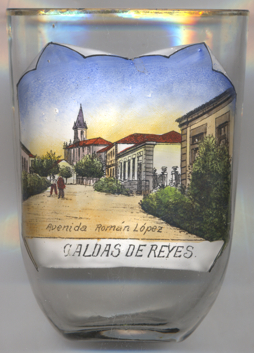

|
| ESPAÑA | Spain |
| Galicia | |
| Provincia de Pontevedra |
Caldas de Reis (official name in Galician; Caldas de Reyes in Castilian Spanish) is situated at an elevation of 47 m on the river Umia in the northwest of the province of Pontevedra in Galicia. It forms part of the Comarca of Caldas, also known as Comarca do Umia, formed by the municipalities of Caldas de Reis, Cuntis, Moraña, Catoira, Valga and Portas. Caldas is its capital; the municpality has a population of about 9,800 (2016).
 The oldest archeological finds demonstrating human presence in the area is the Caldas de Reis Treasure,
more than thirty gold pieces dating from around 1,550 BC. In Ptolemy's (c. 100–c. 170 AD) Tables,
the town appears as Aquae calidae and in the Itinerarium Antonini (3rd century AD) as Aquae Celenae;
Lucas de Tuy (d. 1249) called it Caldas de Rege.
Caldas de Reis was already the seat of a bishop in the 4th century; however, this bishopric was transfered to
Iris Flavia, now Santiago de Compostela, in the mid-6th century. No longer a residential bishopric, Caldas de Reis
is today listed by the Catholic Church as a titular see.
The oldest archeological finds demonstrating human presence in the area is the Caldas de Reis Treasure,
more than thirty gold pieces dating from around 1,550 BC. In Ptolemy's (c. 100–c. 170 AD) Tables,
the town appears as Aquae calidae and in the Itinerarium Antonini (3rd century AD) as Aquae Celenae;
Lucas de Tuy (d. 1249) called it Caldas de Rege.
Caldas de Reis was already the seat of a bishop in the 4th century; however, this bishopric was transfered to
Iris Flavia, now Santiago de Compostela, in the mid-6th century. No longer a residential bishopric, Caldas de Reis
is today listed by the Catholic Church as a titular see.
Alfonso VII (1105–1157), called 'the Emperor', was born in Caldas de Reis. Alfonso became King of Galicia in 1111 and King of León and Castile in 1126. Alfonso first used the title Emperor of All Spain, along with his mother Queen Urraca of León, Castile and Galicia, once his mother vested him with the direct rule of Toledo in 1116.
The  church of St. Thomas of Canterbury (igrexa de San Tomé Becket)
was built with the remains of the 'Tower of Doña Urraca', the residence of the Compostela archbishops
since 1228. The remains that are preserved are the windows and the parapets that we can see embedded in the walls of
the apse of the present parish church. Its name honors the passage of St. Thomas of Canterbury by Caldas de Reis
in 1170.
church of St. Thomas of Canterbury (igrexa de San Tomé Becket)
was built with the remains of the 'Tower of Doña Urraca', the residence of the Compostela archbishops
since 1228. The remains that are preserved are the windows and the parapets that we can see embedded in the walls of
the apse of the present parish church. Its name honors the passage of St. Thomas of Canterbury by Caldas de Reis
in 1170.
The street view depicted on glass no. 3198 is  Avenida
Avenida
[https://es.wikipedia.org/wiki/Caldas_de_Reyes, https://en.wikipedia.org/wiki/Caldas_de_Reis;
http://www.fallingrain.com/world/SP/58/Caldas_de_Reyes.html;
https://en.wikipedia.org/wiki/Ptolemy, https://en.wikipedia.org/wiki/Antonine_Itinerary,
https://en.wikipedia.org/wiki/Lucas_de_Tuy; https://en.wikipedia.org/wiki/Alfonso_VII_of_León;
http://www.galiciaenteira.com/san-tome-caldas-de-reis/;
https://books.google.at/books?id=xYN9FK9j-_4C&pg=PA193&lpg=PA193&dq=%22Rom%C3%A1n+L%C3%B3pez%22+-placerville+-ruiz+caldas&source=bl&ots=Jhn8O8hHiV&sig=ACfU3U1uQBJZLlZjMwh8CePp4yPKBrfg6Q&hl=de&sa=X&ved=2ahUKEwj0g8T5sN3oAhVGzRoKHW_KClsQ6AEwF3oECA0QNA#v=onepage&q=%22Rom%C3%A1n%20L%C3%B3pez%22%20-placerville%20-ruiz%20caldas&f=false,
https://www.lavozdegalicia.es/noticia/pontevedra/caldas-de-reis/2017/03/09/concello-caldas-inicia-restauracion-fonte-da-burga/0003_201703P9C7991.htm]
![[scale]](lineal.jpg)